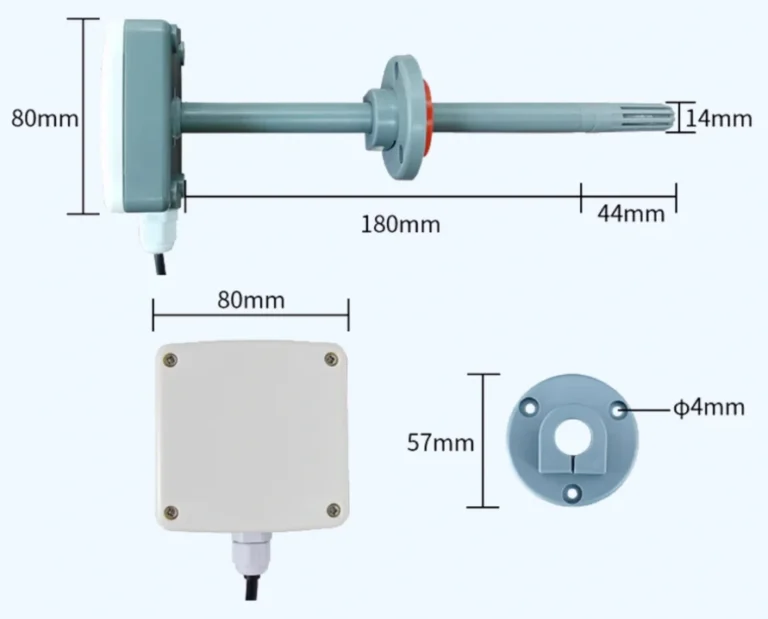Differences Between Temperature and Humidity Sensors with Built-In and External Probes
With the quick changes in today’s world, temperature and humidity sensors are used in many areas. These sensors are important for everyday life. They impact comfort, safety, and efficiency in many industries.
Manufacturers often add built-in or external probes to these sensors for various needs. But how do these two types differ in function and use?
Built-In Probe
Temperature and humidity sensors have built-in probes. Their internal parts are not visible. This design makes them look sleek and attractive.
Built-in probes use very little power. They are less affected by outside factors like aging, vibration, or chemicals. This helps them stay stable over time.
Installed as one unit, they are good for checking environmental conditions in open areas. Common uses include:
– Data centers
– Smart buildings
– Warehouses
– Laboratories
– Clean rooms
External Probe
Sensors with external probes have a sensing unit that is separate from the main device. This separation allows users to measure a wider range. It does not limit the sensor to the same housing as the display and electronics. External probes are especially good for measuring small or tight spaces, such as:
– Drying ovens
– Constant temperature chambers
– Refrigerators
Specialized external probes can measure in unique places like sealed spaces, pipelines, control boxes, and grain storage piles. You can insert them directly into the area you want to monitor. We make many external probes from materials like metal. This improves their durability, waterproofing, and resistance to condensation.
There are different types of external probes made for specific needs.
– **Hardcover Probes**: This product is versatile and works for many uses. It is sensitive, waterproof, and dustproof.
– **Waterproof Probes**: Great for dusty places; less sensitive than hardcover probes at finding small changes.
– **Metal Waterproof Probes**: This probe is made for high-dust areas. It is more sensitive than regular waterproof probes.
– **Quarter-Pipe Threaded Probes**: This is helpful for containers with threaded installations. It allows for accurate temperature and humidity readings inside closed devices.
– **High-Temperature Probes**: Designed to work at temperatures over 80°C.
Calibration: A Crucial Component
Temperature and humidity sensors use advanced technology and physical principles to give accurate readings. However, the hardware only accounts for about 50% of the sensor’s performance. Calibration is just as important.
To keep readings accurate over time, sensors need regular calibration. This helps maintain consistency within set ranges. This can be a tough task in many situations. Precision and stability are key goals for temperature and humidity sensors.
Understanding Their Core Functions
Temperature and humidity sensors can be either integrated or external. They can also be distinguished by their specific focus.
1. **Temperature Sensors**: These devices measure the temperature of an object or the environment. They then send a signal through a transmitter.
2. **Humidity Sensors**: This device is primarily used to measure the moisture levels in the air or objects. It sends the data to a connected system for further processing.
Key Advantages of Temperature and Humidity Sensors
The temperature and humidity sensor has a small design that looks nice. It does more than just measure temperature and humidity. It also serves as a decorative piece for indoor spaces.
The sensor performs very well. It provides accurate and steady measurements. It can detect temperatures from -40℃ to 60℃, with an accuracy of ±0.5℃.
Humidity measurements go from 0% to 100% RH. They have a precision of ±3% RH. This ensures accurate readings in different conditions.
Developers added new software to this sensor. This makes it easy to upload data to a cloud platform. The software has many features. It helps users view and manage their data easily.
Users can access real-time readings from the sensor anytime and anywhere. You can save data in EXCEL or TXT formats. This makes it easy to use the data in different workflows.
A key feature of the sensor is its clear LCD screen. This screen makes real-time data easy to read. It also has an alarm system that turns on when temperature or humidity goes above set limits.
In these cases, the device makes a buzzer sound and sends alerts through SMS, phone calls, and email. Customers can easily change key settings using simple button controls. – You need to set the high and low limits for temperature and humidity alarms.
– You also need to change the baud rate.
– Finally, you should set the address.
The sensor is designed to be easy to use. Its back panel can be mounted on a wall or placed on a countertop with the included bracket. Additionally, a quick-action key switch makes operations simpler and improves convenience during installation and regular use.
In today’s changing market, environmental monitoring systems have improved in function and efficiency. These systems are popular because they are flexible and come in different designs for various needs.
Are you looking for products that give great results? Check out Rika Sensors for innovative solutions that blend design and reliability.
conclusion
For companies like Hunan Coda Electronic Tech Co., Ltd, it is important to find a product. The product should be affordable. It should also be high-quality. Our industry expertise drives us to offer customized solutions that add value at every sensor – development stage.
We regularly review and apply strategies to meet changing customer needs and market trends. Hunan Coda Electronic Tech Co., Ltd works with integrity and follows high ethical standards. We act responsibly, focusing on the well-being of our team and the communities we serve. This helps us grow sustainably, which aligns with our values.
